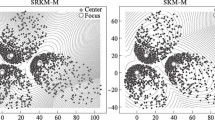Abstract
We present a new iterative method for probabilistic clustering of data. Given clusters, their centers and the distances of data points from these centers, the probability of cluster membership at any point is assumed inversely proportional to the distance from (the center of) the cluster in question. This assumption is our working principle.
The method is a generalization, to several centers, of theWeiszfeld method for solving the Fermat–Weber location problem. At each iteration, the distances (Euclidean, Mahalanobis, etc.) from the cluster centers are computed for all data points, and the centers are updated as convex combinations of these points, with weights determined by the above principle. Computations stop when the centers stop moving.
Progress is monitored by the joint distance function, a measure of distance from all cluster centers, that evolves during the iterations, and captures the data in its low contours.
The method is simple, fast (requiring a small number of cheap iterations) and insensitive to outliers.
Similar content being viewed by others
References
ARAV, M. “Contour Approximation of Data and the Harmonic Mean”, Mathematical Inequalities & Applications, (to appear).
BEZDEK, J.C. (1973), “Fuzzy Mathematics in Pattern Classification”, Ph.D. Thesis (Applied Mathematics), Cornell University, Ithaca, New York.
BEZDEK, J.C. (1981), Pattern Recognition with Fuzzy Objective Function Algorithms, New York: Plenum.
DIXON, K.R., and CHAPMAN J.A. (1980), “Harmonic Mean Measure of Animal Activity Areas”, Ecology 61, 1040–1044.
HARTIGAN, J. (1975), Clustering Algorithms, New York:John Wiley & Sons, Inc.
HEISER, W.J. (2004), “Geometric Representation of Association Between Categories”, Psychometrika 69, 513–545.
HÖPPNER, F., KLAWONN, F., KRUSE, R., and RUNKLER, T. (1999), Fuzzy Cluster Analysis, Chichester, England:John Wiley & Sons, Inc.
HUBERT, L., and STEINLEY, D.(2005), “Agreement Among Supreme Court Justices: Categorical vs. Continuous Representation”, SIAM News, 38(7).
IYIGUN, C., and BEN-ISRAEL, A. “Probabilistic Distance Clustering Adjusted for Cluster Size”, Probability in the Engineering and Informational Sciences, (to appear).
IYIGUN, C., and BEN-ISRAEL, A. “A GeneralizedWeiszfeldMethod for Multifacility Location Problems”, (to appear).
IYIGUN, C., and BEN-ISRAEL, A. “Probabilistic Distance Clustering, Theory and Applications”, W. Chaovalitwongse, P.M. Pardalos (Eds.), Clustering Challenges in Biological Networks, World Scientific. (to appear)
IYIGUN, C., and BEN-ISRAEL, A. “A New Criterion for Clustering Validity via Contour Approximation of Data”, (to appear).
IYIGUN, C., and BEN-ISRAEL, A. “Probabilistic Semi–Supervised Clustering”, (to appear).
JAIN, A.K., and DUBES, R.C. (1988), Algorithms for Clustering Data, Prentice Hall.
KUHN, H.W. (1973), “A Note on Fermat’s Problem”, Math. Programming 4, 98–107.
LOVE, R., MORRIS, J., and WESOLOWSKY, G. (1988), Facilities Location: Models and Methods, North-Holland.
OSTRESH Jr., L.M. (1978), “On the Convergence of a Class of Iterative Methods for Solving the Weber Location Problem”, Operations Research 26, 597–609.
TAN, P., STEINBACH, M., and KUMAR, V. (2006), Introduction to Data Mining, Addison Wesley.
TEBOULLE, M. (2007), “A Unified Continuous Optimization Framework for Center-Based ClusteringMethods”, Journal of Machine Learning 8, 65–102.
WEISZFELD, E. (1937), “Sur le point par lequel la somme des distances de n points donn´es est minimum”, Tohoku Math. J. 43, 355–386.
Author information
Authors and Affiliations
Corresponding author
Rights and permissions
About this article
Cite this article
Ben-Israel, A., Iyigun, C. Probabilistic D-Clustering. J Classif 25, 5–26 (2008). https://doi.org/10.1007/s00357-008-9002-z
Published:
Issue Date:
DOI: https://doi.org/10.1007/s00357-008-9002-z




